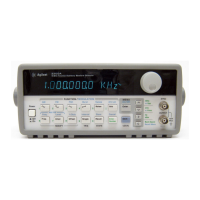For triggered burst operation, the function generator creates an internal
modulation signal which is exactly synchronous with the carrier waveform.
This internal modulation signal is used to halt waveform memory
addressing when the last data point is reached. This modulation signal
effectively “gates” the output “on” and “off” for the specified number of
carrier wave cycles. The modulation signal is then triggered by another
internal burst rate signal generator which controls how often the
specified carrier burst is output. In external triggered burst operation,
the modulation signal trigger source is set to the function generator’s
rear-panel Ext Trig terminal. This source replaces the internal burst
rate signal generator for pacing triggered bursts.
Changes to the burst count, burst rate, burst phase, or carrier frequency
will cause the function generator to automatically compute a new
modulation signal and download it into modulation
RAM. It is not
possible for the function generator to burst single cycles for all carrier
frequencies because the internal modulation signal generator is not as
capable as the main carrier signal generator. The table below shows the
function generator’s carrier frequency and burst count limitations.
Carrier
Frequency
10 mHz to 1 MHz
>1 MHz to 2 MHz
>2 MHz to 3 MHz
>3 MHz to 4 MHz
>4 MHz to 5 MHz
Minimum
Burst Count
1
2
3
4
5
For sine, square, and
arbitrary waveforms only.
Chapter 7 Tutorial
Modulation
292

